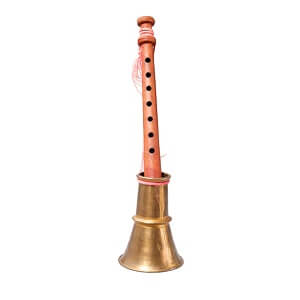Hne
 The hne is a conical early woodwind musical instrument of double reeds that is used in the music of Myanmar. The earliest existing written occurrence of the word hne was traced back to the 1491 CE and it is likely a Middle Mon loan word that was derived from ‘sonay’.
The hne is a conical early woodwind musical instrument of double reeds that is used in the music of Myanmar. The earliest existing written occurrence of the word hne was traced back to the 1491 CE and it is likely a Middle Mon loan word that was derived from ‘sonay’.
The hne has a six times reeds that is made from the young leaf of the toddy palm that is soaked for about six months. The body of the instrument is produced from wood with a conical bore and seven finger holes at the front of the instrument that are set in a straight line with a bell hung on top of the instrument. The hne has a showy metal bell and has a loud tone. This musical instrument is often used in a group together with the xylophone, tuned gong and some other tuned drums. There are two different types of the hne; the smaller form that is called the “hne galay”, and the larger size that is called the “hne gyi”. The hne galay is used for songs in common key of the relating scale while the hne gyi is used for grand pattern songs in the fourth note in major or minor musical scale mode.